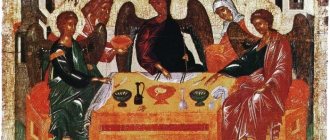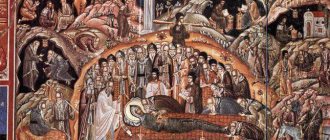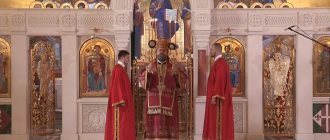Basic rules of the Orthodox funeral rite
According to the rules, the Orthodox funeral rite takes place in several stages, each of which is important:
- ablution - carried out immediately after the death of a person, this procedure includes washing the deceased with the parallel reading of special prayers;
- vestment - this concept includes putting clothes on the deceased;
- placing the body in a coffin;
- laying out all the necessary paraphernalia, namely a cross, shroud or icon;
- prayers for the repose of the deceased;
- funeral service for the sins of a Christian that he may have committed during his life;
- burial of a deceased person in an Orthodox cemetery;
- commemoration.
In general, the funeral procedure has a vague meaning in Christianity. According to the Bible, it makes no difference to a deceased person how the burial was conducted. This is due to the fact that even Jesus Christ was buried hastily. For this reason, the myrrh-bearers tried to honor him as quickly as possible.
Based on this, it does not matter how exactly the person was buried. For example, if he died in the mountains or went missing, this will not in any way affect his posthumous fate in the Kingdom of Heaven. Basically, all the necessary rituals are carried out not so much for the deceased, but for his close people who want to release the person in accordance with all Orthodox canons.
There are a large number of different rituals, as well as superstitions that accompany them. One of the most common is placing his favorite things in the coffin of the deceased so that he can use them in his new life. However, the problem is that the Bible does not indicate the need for things from the physical world. Therefore, such a procedure is nothing more than a superstition that dates back to the times of pagan customs.
Ablution
Immediately after a person dies, a ritual of cleansing the body, called ablution, is performed. This procedure is done so that the deceased appears before the Lord God pure and blameless. According to the scriptures, this procedure should be performed by men for men and, accordingly, by women for women.
However, today they are increasingly deviating from this rule by ordering a special service.
Ablution is carried out using warm water and clean sponges or rags. The body is completely undressed, placed on a flat surface covered with a white cloth, and the deceased is washed. The procedure begins from the head and slowly descends below, while the person who performs the ablution makes certain movements with his hands, and also reads a prayer. The gaze of the deceased is directed towards the icons. After the procedure, all clothes that were previously worn by the deceased should be burned and buried.
vestment
After washing, the body is dressed. Many elderly people independently prepare the outfit they want to use during burial. Therefore, it is better to fulfill the will of the deceased and dress him in clothes prepared in advance. The main rule is that the outfit must be clean and new, the shoes must also match, but it is not necessary to buy white shoes - any formal style will do.
Entombment
The deceased person is placed in the coffin in such a way that it is located in relation to the icons. In this case, the eyes are first closed (if they were open), the lips are also closed (if necessary, the jaw is tied up). The hands of the deceased lie crosswise on the chest.
Cross, shroud, icon
According to the rituals, the deceased should have a small icon or Orthodox cross in his hands. The body can also be wrapped in a shroud - this is a special fabric in which, according to the scriptures, deceased people were previously wrapped.
Prayer
After the body of the deceased has been washed, dressed and placed in a coffin, a canon called “Following the Exodus of the Soul” should be read. The texts of this prayer can be found in any complete Prayer Book:
“Holy God, Holy Mighty, Holy Immortal, have mercy on us. (Three times)
Glory to the Father and the Son and the Holy Spirit, now and ever and unto ages of ages. Amen.
Most Holy Trinity, have mercy on us; Lord, cleanse our sins; Master, forgive our iniquities; Holy One, visit and heal our infirmities, for Thy name's sake.
Lord have mercy. (Thrice)
Glory to the Father and the Son and the Holy Spirit, now and ever and unto ages of ages. Amen.
Our Father, who art in heaven! Hallowed be Thy name, Thy kingdom come, Thy will be done, as it is in heaven and on earth. Give us this day our daily bread; and forgive us our debts, just as we forgive our debtors; and do not lead us into temptation, but deliver us from the evil one.
Lord have mercy". (12 times)
Lithium
An hour before the removal of the body, a funeral litany is read; its text can also be found in the Prayer Book:
“Through the prayers of our holy fathers, Lord Jesus Christ our God, have mercy on us. Amen.
Holy God, Holy Mighty, Holy Immortal, have mercy on us. (Thrice)
Glory to the Father and the Son and the Holy Spirit, now and ever and unto ages of ages. Amen.
Most Holy Trinity, have mercy on us; Lord, cleanse our sins; Master, forgive our iniquities; Holy One, visit and heal our infirmities, for Thy name's sake.
Lord have mercy. (Thrice) Glory, and now:
Our Father, who art in heaven, hallowed be your name, your kingdom come, your will be done, as it is in heaven and on earth. Give us this day our daily bread; and forgive us our debts, just as we forgive our debtors; and do not lead us into temptation, but deliver us from the evil one.
And this troparia is sung. Voice 4:
From the spirits of the righteous who have passed away, / give rest to the souls of Thy servant, O Savior, / preserving them in the blessed life / which belongs to Thee, O Lover of Mankind.
In Thy chamber, O Lord, / where all Thy saints rest, / rest the souls of Thy servant, / for Thou art the only Lover of mankind.
Glory: Thou art the God who descended into hell, and who looseth the chains of the bound, / Givest rest to Thy servant himself.
And now: One pure and immaculate Virgin, who gave birth to God without a seed, / pray that their souls may be saved.”
Prayer
“Remember, O Lord our God, in faith and hope the life of your eternal departed servant (your fallen servant, your departed servant) (their names), and for he is good and a lover of mankind, forgiving sins, and consuming know the untruth, weaken it, leave it, and forgive all voluntary of his (her) sins and involuntary, restoring him (s) at Your holy second coming into the communion of Your eternal blessings, for the sake of the only believer in You, the true God and mankind btsa; For Thou art the resurrection and life, and rest unto Thy servant (Thy servant, Thy servant) (their names), Christ our God, and to Thee we send glory, with Thy beginningless Father, and with the Most Holy Spirit, now and ever and unto ages of ages, Amen".
Kontakion, tone 8
Rest with the saints, / Christ, Thy servant of the soul, / where there is no sickness, no sorrow, / no sighing, / but endless life.
Ikos
You yourself are the only immortal, / who created and created man: / from earth we were created from the earth, / and into the earth we will go, / as you commanded, who created me and who gave me rivers: / I For thou art the earth, and unto the earth thou shalt go: / and perhaps all men let's go, / funeral lament, creating a song: / alleluia, alleluia, alleluia.
It is worthy to eat as you truly bless Theotokos, Ever-Blessed and Most Immaculate and Mother of our God. We magnify Thee, the most honorable Cherub and the most glorious without comparison, the Seraphim, who gave birth to God the Word without corruption.
Glory, and now: Lord, have mercy, three times.
Possess the living and the dead, Lord, Jesus Christ, Son of God, through the prayers of Your Most Pure Mother, the glorious and all-praiseworthy Apostles, the venerable and God-bearing Fathers ours and all the saints, the souls of your servants [names] who departed from us, create in the villages of the righteous, in the depths Give Abraham rest and be with the righteous, and have mercy on us, as you are Good and Lover of Mankind. Amen. And Abiye: In the blessed dormition, grant eternal rest, O Lord, to Your departed servant [name], and create for them an eternal memory.
They sing: Eternal memory, three times.
Traditionally they also sing:
Their souls will be established in goodness, and their memory will endure forever.
Holy God, Holy Mighty, Holy Immortal, have mercy on us. (Thrice)
Funeral service
The funeral service is often held in a church, but the procedure can also be carried out at home - for this you need to call the priest. After the body of the deceased is delivered to the temple, it is positioned in such a way that the gaze is directed to the sacred altar, and lamps surround it on 4 sides of the coffin.
The funeral service takes place on the 3rd day after death, since this period is considered the most difficult for the deceased; special canons and the Psalter are read over it.
After the funeral service, a farewell ritual is carried out, the main function of which is to sing touching stichera, which indicate that the deceased leaves frailty and all earthly vanity. After this, the relatives and acquaintances of the deceased walk around the coffin, bow and ask to forgive them for various grievances that may have occurred during life. A special aureole or a small icon is placed on the deceased, which anyone can kiss. After this, the body is covered with a white cloth, the priest covers it with earth using cruciform movements, the coffin is taken out of the temple, while chanting the “Trisagion”:
“Holy God, Holy Mighty, Holy Immortal, have mercy on us. (Bow)
Holy God, Holy Mighty, Holy Immortal, have mercy on us. (Bow)
Holy God, Holy Mighty, Holy Immortal, have mercy on us. (Bow)
Glory to the Father and the Son and the Holy Spirit, now and ever and unto ages of ages. Amen".
Burial
During burial, the coffin with the deceased person is turned so that his face is directed to the East, this is necessary so that the deceased can expect to meet the Son of God. After this, the coffin is slowly lowered into the ground; during this procedure, people, including clergy, chant the Trisagion. Finally, everyone is given the opportunity to throw a small lump of earth on the coffin, this indicates submission to the highest providence. After this, the hole is dug and a correct and necessarily eight-pointed cross is installed; it must be dug in from the side of the deceased’s feet.
Commemoration
After the burial stage comes commemoration, churches and temples constantly offer prayers for the deceased, and Orthodoxy also allows for private commemorations if the relatives of the deceased have a pious desire.
Blessing of water
Currently, the blessing of water is performed in all churches of the Russian Orthodox Church, and all believers have access to holy water. The consecration of water as a rite is of two types: the small consecration of water and the great. After the great consecration, we call the water the great agiasma, or the great shrine. Such consecration occurs only twice a year, on the feast of Epiphany (Epiphany) and on its eve. The blessing of water is performed on this day not only in churches, but also on rivers and reservoirs. If a priest or bishop on the feast of Epiphany goes to bless water in a natural open reservoir, then such consecration is called “going to the Jordan,” in honor of the Baptism of Jesus Christ in the Jordan River. In Rus', the consecration of water on the eve of the holiday took place in the temple, and on the holiday itself at the “Jordan”, i.e. in the ice hole, into which those who wished would plunge after completing the rite[].
The rite of small consecration of water is performed more often than the great one. The main days when water is blessed: on the Feast of the Origin of the Trees (August 1), on the holiday in honor of the icon of the Mother of God “Life-Giving Spring” (on Friday of Bright Week), on the eve of Pentecost, on the day of the patronal feast of the temple. However, in addition to those listed, water is sanctified at the request of believers on other days. Many churches have a tradition of blessing water every Sunday so that believers can always drink holy water.
Holy water is used by believers with reverence and prayer for the healing of soul and body[].
Funeral table menu
During the wake, you also need to adhere to certain customs and set the table only with certain dishes, including:
- kutia - this dish is prepared from grains of rice or wheat, honey, raisins and occasionally other sweets are also added to it; it is also important that this dish is first consecrated at the funeral service;
- various meat snacks, which may vary depending on the wishes of relatives;
- pickles and salads, often using familiar vegetables: white cabbage, cucumbers, tomatoes, carrots, onions;
- Some dish of chicken eggs must be present; they are often stuffed;
- fried or salted fish;
- the first course is usually served with borscht or beetroot soup, depending on the wishes of relatives;
- Buckwheat porridge is often used as a side dish, but pilaf or mashed potatoes are also available;
- at the end of the funeral table, according to tradition, pancakes with honey or sweet pies are served;
- Drinks include fruit compote or jelly; if desired, there may be alcoholic drinks.
Unction
Orthodox holidays and rituals are often confused with each other, and this is what happened with the sacrament of unction. Not only are these concepts confused, but people are also misled by the fact that oil is used in both cases. The difference is that during unction, God’s grace is invoked, but in the second, the rite is only symbolic.
By the way, the sacrament of unction has always been considered the most difficult action, because according to church canons seven priests must perform it. Only in extreme cases is it permissible for one priest to perform the sacrament. The anointing is done seven times, during which passages from the Gospel are read. In particular, chapters from the Epistle of the Apostles and special prayers that are intended specifically for this occasion are heard. But the ritual of anointing consists only in the fact that the priest blesses and places a cross on the forehead of a believer.
More rituals associated with funerals
There are also a large number of rituals that are performed depending on the situation. In order, according to the Bible, to make it easier for a person in the next world, various rituals and procedures should be carried out, because their correct implementation is very important in Christianity.
Man on the verge of death
If a person is on his deathbed, the priest should be called to him for confession or so that he can repent and pray for his possible sins. Also, this right should be granted to those who have not been adherents of the Orthodox Church throughout their lives. This tradition is also connected with the fact that people who were not Christians cannot be buried in churches and buried in Orthodox cemeteries. And for this reason, their souls go to the next world uninveterate and appear before the Lord God as sinners.
It should also be taken into account that relatives cannot in any way influence the possibility of a funeral service, since if they conceal the fact that the deceased was not a Christian, they will thereby incur a terrible sin.
Fatal illness
In the event of a fatal illness, one should pray for the forgiveness of the sins of the sick person who could have received them in worldly life. For good health, you can light a candle and call a priest to a relative so that he can confess the patient and, if necessary, atone for his sins during his lifetime. This procedure will help the human soul after death.
Before the funeral
After a person has died, the first step is to complete all the necessary documentation. The main document is the death certificate form. This document is issued by a doctor. He does this if a person dies in a hospital (if he was sick or was on his deathbed); or a local doctor who arrived at the house on a private ambulance call.
In addition to the death declaration form, a protocol for examining the body of the deceased should be drawn up, which should be drawn up by law enforcement officers; they should be called immediately after the death. They can also arrange a referral for a forensic autopsy if they consider the death to be unnatural. Often, if a person was very old or had serious health problems (as evidenced by a medical record and medications), such a referral is not issued.
In general, it is imperative to collect the following documentation:
- form for ascertaining the death of a person;
- ID of the deceased;
- the passport of the person who will directly handle all paperwork;
- medical card and insurance policy of the deceased;
- body inspection report.
You should go to the clinic and the reception desk with all the papers. If there are no suspicions of non-violent or unnatural death, the district police officer issues a corresponding certificate addressed to the head physician of the district clinic. This paper is needed to obtain a medical certificate of death.
However, it can only be obtained if there is an outpatient card of the deceased in the hospital, which will display the presence of any disease and dynamic indicators of his general condition. If such evidence is not available, the hospital may refuse to issue a certificate.
If such a situation occurs, the chief physician has the right to send the body for a pathological examination to identify the exact causes of death. Based on the evidence received, after the autopsy, a medical death certificate is issued or the investigation procedure begins with all subsequent procedures.
In the temple
Previously, it was customary to leave the coffin with the deceased in the temple overnight so that more relatives and acquaintances of the deceased could participate in the funeral prayer. This reading took place throughout the night and ended only with the onset of morning.
Commemoration on the 3rd, 9th and 40th days
The commemoration takes place at:
- Day 3 - the funeral ritual is carried out according to the apostolic tradition, since any believer is baptized in the glory of the Trinity. During the first two days, the soul of the deceased wanders near his own home, in which the funeral service should take place at this time.
- Day 9 - at this time the Orthodox Church conducts prayer requests and makes bloodless sacrifices. For 6 days, the beauties of Paradise are revealed to the deceased, and the soul glorifies the Lord God, while all worldly suffering and pain that were ever associated with the body are forgotten. At the same time, sinners reproach themselves by admiring the beauty of Paradise until they receive Divine pardon.
- 40-day period - in the period from 9 to 40 days, the soul of a deceased person is shown the halls of hell, in which various nightmarish sufferings and tortures of sinful souls are demonstrated. At this time, the church conducts petitions, reads prayers and makes bloodless sacrifices to obtain benefits for the deceased Christian. After 30 days of wandering through the halls of hell, the soul goes back to worship and waits for what kind of decision the Lord God will make and what place he will determine.
After 40 days
After 40 days have passed since the death of a person, you can and even need to order a memorial service for the deceased. It is during this period that the soul returns to the Lord God so that he can determine exactly where the person will end up.
A memorial service is a funeral service for the dead, which consists of a series of prayers and is performed in a church. The main task of such texts is to rely on God’s mercy for the forgiveness of various acts and sins of the deceased during his lifetime and the granting of blessed eternal life to the soul. Such prayers are usually held not only before the burial of a body, but also on the 3rd, 9th and 40th day after the death of a person. After 40 days, memorial services should be performed on the birthdays of the deceased and anniversaries of death.
Death anniversary
On each anniversary of a person's death, a wake is held. It is also better to set the table for them, including all the special items from the funeral menu. In addition, according to Christian customs, these days it is customary to order a memorial service in the church, which should help the deceased live better in the Kingdom of the Lord.
Prayer service
A prayer service, or prayer singing, is a special divine service in which the gracious help of the Lord Jesus Christ, the Blessed Virgin Mary, the Heavenly Powers or the saints of the Orthodox Church is asked. Prayer services serve not only to ask for help in various needs, but also to give thanks for the blessings of God received.
Prayer services are served not only in churches, but also in the homes of believers, on the streets, in the field (when there is no rain), in schools (at the beginning of school), etc.
Prayer services have always been served in Rus', and this was the natural desire of people to ask God for blessings in common prayer. Konstantin Paustovsky describes the following general prayer service in “The Tale of Forests”: “The next morning a priest came from Paramonov with a psalm-reader to serve a prayer service for the sending of rain. All the people with banners came out to a hillock among the fields - from that hillock in clear weather the right bank of the Volga was visible."
Currently, in many churches a prayer service is served every day after the Liturgy - the so-called rite of general prayer. Metropolitan Hilarion (Alfeev) notes: “The almost universal distribution of prayers in the Russian Church testifies to the development of liturgical piety towards semantic simplification with the replacement of more ancient, lengthy and complex texts with simpler, concise and accessible ones”[]. However, not only the ease of perception of prayers serves to spread them. This is also facilitated by directly voicing the requested things: if it is the beginning of the year - a prayer service with petitions for a favorable year; if there is a drought - a prayer service with requests for rain. And, undoubtedly, the desire of people to order a prayer service and come to pray at it grows from service to service.
Russian mourning ritual traditions and customs
There are several Russian mourning traditions and customs that will be incomprehensible to representatives of other religions:
- Washing the dead - this ritual was carried out in various cultures, but among the Russian people it had a number of specific differences. The body of the deceased was positioned in such a way that his legs were laid towards the stove, and women who were not capable of bodily sin for a number of reasons often acted as washers. They usually received the deceased's clothing as payment.
- Until the 20th century, the Russian people independently prepared all the equipment necessary for burial. Particular respect was given to those who independently put together a coffin for themselves or sewed an outfit.
- According to beliefs, it is impossible to leave the deceased alone in the apartment, since in the first 3 days his soul is very vulnerable to various otherworldly forces and therefore one of the relatives must stay and read prayers over the body. However, in fact, this tradition came to the Russian people since the times of paganism. According to Christian scriptures, there is no need to perform such rituals.
- Covering mirrors with white cloth is a long-standing tradition that has been done for various reasons. The most common are two. The first says that after the death of a person, moments from the life of the deceased begin to be shown in the mirror, and the one who sees them can soon go after the deceased. Another interpretation says that this is done for the safety of the soul of a dead person, so that his soul cannot get lost in the looking glass.
Consecration of the temple
In Rus', in the place where people began to settle, the first thing they did was build a temple. The temple, like everything produced on earth for the salvation of believers, must be sanctified. After all, a temple is an “ordinary” building until the moment when the rite of consecration is performed over it. After the perfect rite, the temple acquires new qualities, because becomes the receptacle of the greatest shrine[]. From the very beginning of construction, the temple, as the greatest shrine of the Church, has been accompanied by the prayers of believers. It is not without reason that a number of prayer services are associated with the construction of the temple building. This includes the rite of founding the temple, the rite of erecting crosses on the domes, the rite of consecrating the bells, and directly the rite of consecrating the temple itself.
The rite of the great consecration of the temple is usually performed by the ruling bishop. On the eve of the consecration in the evening, a service for the Renewal of the Temple is performed in the temple, and immediately on the day of consecration, before the service, a water prayer service is performed. During consecration, a particle of the relics of a saint is placed at the base of the throne, which constitutes the main shrine of the consecrated temple. A religious procession is carried out with this particle of relics. Also, a particle of the relics is placed in the antimension.
An antimension is a small silk or linen cloth that is placed on the throne and on which the Transfiguration of the Holy Body and Blood of Jesus Christ is performed. The antimension or instead of the throne is consecrated by the bishop, so that “if for some reason he cannot consecrate the temple, only the antimension is consecrated. Subsequently, this antimension is sent to the church for which it is intended, and the consecration of the temple itself is performed by the priest. The rite of consecration of the antimensions includes many moments from the Great Consecration of the Temple by the Bishop.”[].
Immediately after the great consecration of the temple, the first Liturgy is served on the newly consecrated altar - a sign that the temple has been consecrated and will serve as a House of Salvation for believers.
Whom the Church does not perform a funeral service in Orthodoxy
Priests of the Orthodox Church are guided by church canons and have the right to refuse funeral services for people who:
- died in a state of severe alcohol or drug intoxication;
- professed another religion;
- treated Christianity with contempt or mockery;
- were unbaptized;
- died in infancy and did not have time to undergo baptism;
- committed suicide.
There are also many exceptions to this rule that can play a key role in the possibility of a funeral service. For example, if a person who committed suicide did it by accident (fell from a cliff, unknowingly ate poisoned berries) or sacrificed his life for the sake of others, a funeral service can be held for such a person.
Also, the ban does not apply to people who have any psychological disabilities and do not understand what they are doing.
Akathist
In many churches and monasteries in our time, prayer singing is performed with akathists joining them. This practice has become widespread only in the territory of the Russian Orthodox Church and only over the last one and a half to two centuries[].
Akathists are touching church works. The word “akathist” is of Greek origin and means “a hymn that one does not sit while singing,” in contrast to “kathisma.” The akathists are quite simple in content and are easily memorized by ear by believers. (For example, akathists to saints are compiled according to the principle of a brief transcription of the content of their lives). That is why the number of akathists has grown incredibly over the past decades. The total number of akathist texts is over 1200[].
There are akathists to the Savior, the Mother of God, the Guardian Angel, and any of the saints. In the statutes regulating the rule by which it is necessary to prepare for communion, there is an akathist (to the Sweetest Jesus or to the Mother of God). “The frequent repetition of the name Jesus and the name of the Mother of God introduces the reader into living communication and relationship with the Savior and the Mother of God”[].
About the funeral service in absentia in church
The practice of absentee funeral services in churches is becoming more and more common, but the possibility of such a procedure is still being debated to this day. On the one hand, such a ritual is necessary for those who are in distant countries abroad or for those whose deceased drowned or died in a fire. In such cases, relatives do not have the opportunity to conduct a standard church funeral, therefore an absentee procedure is the only way out that will allow everything to be done in accordance with Christian canons.
Baptism
Among Orthodox sacraments and rituals, baptism is very popular. Even secular people want to baptize their children. A child can be baptized after forty days have passed from birth. To conduct the ceremony, the presence of godparents is sufficient. As a rule, they are chosen from the closest people. Godparents must be chosen very carefully, because they are obliged to spiritually educate the godson and support him throughout life. Now the rules are not so severe; if previously the mother could not be present at baptism, now this rule applies only for forty days from the birth of the child.
During baptism, the child must be dressed in a new baptismal shirt and be in the arms of one of the godparents. During the ceremony, the latter pray and are baptized together with the priest. God's servant carries the baby around the font three times, and also dips him into the font three times. During baptism, a strand of hair is cut from the child's head, which symbolizes submission to God. At the end of the ceremony, the boys are brought behind the altar, but the girls are leaned against the face of the Mother of God.
People believe that if a person has undergone the rite of baptism, then he will be provided with God's help in all his endeavors. The Savior will save you from sins and troubles, and will also give you a second birth.
Debunking popular myths
There are a number of pagan and folk customs that still exist in Orthodoxy and have not been completely eradicated by time:
- Placing coins, favorite things of the deceased, or an ax in a coffin or grave. In fact, this ritual was formed during the period of paganism and has nothing to do with Christian rituals.
- Another custom is to place teeth that fell out during life or even lost limbs in a coffin with the deceased. In paganism, it was believed that if you bury a person without an arm or leg, then he will remain crippled in the next world.
- Hanging mirrors is another fairly common custom that originates from paganism. In fact, there is no need to carry out such a procedure in Christian burial rites.
In addition to the traditions that came to people from paganism, there are also folk signs and rituals that arose from their own imagination. Most of these customs arose in the pre-revolutionary period, when a large number of superstitions arose:
- placing food or other necessities in the coffin of the deceased;
- impossibility of moving the coffin by relatives;
- at a wake, place a glass of vodka and a piece of bread for the deceased;
- pour vodka into the grave;
- keep the glass from the funeral until 40 days after death;
- say the established expression “Rest in peace”;
- if the deceased was not buried as expected, then his soul will wander the earth;
- burial soil received at an absentee funeral cannot be stored for more than 1 day;
- cremation of the body leads to illness in those who ordered such a procedure.
Anointing
To make it clearer what we are talking about, let's look at the most popular rituals. Anyone who has ever been to a church morning service has seen him or even participated in this ritual. During the ritual, the priest makes cross-shaped movements on the forehead of the believer with oil (blessed oil). This action is called anointing. It means God's mercy, which is poured out on man. Some Orthodox holidays and rituals have come to us since Old Testament times, and anointing is one of them. Moses also commanded that Aaron and his descendants, the servants of the Jerusalem Temple, be anointed with oil. In the New Testament, the Apostle James, in his conciliar letter, mentions the healing effect of oil and says that this rite is very important.











